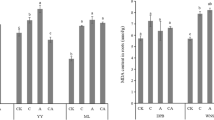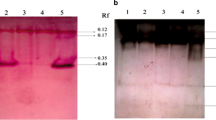Abstract
The effects of Zn deficiency on antioxidant responses of two pea (Pisum sativum L.) genotypes, a Zn-efficient IPFD-99-13 and Zn-inefficient KPMR-500, grown in sand culture were studied. In the pea genotype KPMR-500, Zn deficiency decreased dry matter yield, tissue Zn concentration, and antioxidant enzyme activities istronger than in the genotype IPFD-99-13. Genotype IPFD-99-13 developed more efficient antioxidant system to scavenge ROS than genotype KPMR-500. Zinc deficiency produced oxidative damage to pea genotypes due to enhanced accumulation of TBARS and H2O2 and decreased activities of antioxidant enzymes (Cu/Zn superoxide dismutase (SOD), catalase (CAT), peroxidase (POD), and ascorbate peroxidase (APX)). In the leaves of IPFD-99-13 genotype, the higher activity of ROS-scavenging enzyme, e.g., SOD, CAT, POD, and glutathione reductase, and antioxidants, such as ascorbate and non-protein thiols, led to the lower accumulation of H2O2 and lipid peroxides. These results suggest that, by maintaining an efficient antioxidant defense system, the IPFD-99-13 genotype shows a lower sensivity to Zn deficiency than the KPMR-500 genotype.
Similar content being viewed by others
Abbreviations
- APX:
-
ascorbate peroxidase
- CA:
-
carbonic anhydrase
- Car:
-
carotenoids
- CAT:
-
catalase
- Chl:
-
chlorophyll
- Cu/Zn SOD:
-
copper/zinc superoxide dismutase
- DHAR:
-
dehydroascorbate reductase
- GR:
-
glutathione reductase
- NPT:
-
non-protein thiols
- POD:
-
peroxidase
- TBARS:
-
thiobarbituric acid-reactive substances
References
Singh, B., Kumar, S., Natesan, A., Singh, B.K., and Usha, K., Improving Zinc Efficiency of Cereals under Zinc Deficiency, Curr. Sci., 2005, vol. 88, pp. 36–44.
Rengel, Z., Genotypic Differences in Micronutrient Use Efficiency in Crops, Commun. Soil Sci. Plant Anal., 2001, vol. 32, pp. 1163–1186.
Cakmak, I., Ozturk, L., Eker, S., Torun, B., Kalfa, H.I., and Yilamaz, A., Concentration of Zinc and Activity of Copper/Zinc-Superoxide Dismutase in Leaves of Rye and Wheat Cultivars Differing in Sensitivity to Zinc Deficiency, J. Plant Physiol., 1997, vol. 151, pp. 91–95.
Hacisalihoglu, G., Hart, J.J., Wang, Y.H., Cakmak, I., and Kochain, L.V., Zinc Efficiency Is Correlated with Enhanced Expression and Activity of Cu/Zn Superoxide Dismutase and Carbonic Anhydrase in Wheat, Plant Physiol., 2003, vol. 131, pp. 595–602.
Ellis, D., Lopez-Millan, A.F., and Grusak, M.A., Metal Physiology and Accumulation in a Medicago traunculata Mutant Exhibiting an Elevated Requirement for Zinc, New Phytol., 2003, vol. 158, pp. 207–218.
Cakmak, I., Possible Roles of Zinc in Protecting Plant Cells from Damage by Reactive Oxygen Species, New Phytol., 2000, vol. 146, pp. 185–205.
Hacisalihoglu, G., Hart, J.J., Edwards, V.C., and Kochain, L.V., The Role of Shoot Localized Process in the Mechanism of Zn Efficiency in Common Bean, Planta, 2004, vol. 218, pp. 704–711.
Pathak, G.C., Pandey D.K., Gupta, B., and Pandey, N., Zinc Homeostasis Is Critical for Optimized Antioxidative Defense in Faba Bean, Indian J. Plant Physiol., 2009, vol. 14, pp. 60–66.
Chen, W.R., He, Z.L., Yang, X.E., and Feng, Y., Zinc Efficiency Is Correlated with Root Morphology, Ultra Structure, and Antioxidative Enzymes in Rice, J. Plant Nutr., 2009, vol. 32, pp. 287–305.
Sharma, C.P., Deficiency Symptoms and Critical Concentration of Micronutrient in Crop Plants, Lucknow: Lucknow Univ. Center, 1996.
Lichtenthaler, H.K., Chlorophylls and Carotenoids: Pigments of Photosynthetic Biomembranes, Methods Enzymol., 1987, vol. 148, pp. 350–382.
Law, M.Y., Charles, S.A., and Halliwell, B., Glutathione and Ascorbic Acid in Spinach (Spinacia oleracea) Chloroplasts. The Effect of Hydrogen Peroxide and of Paraquat, Biochem. J., 1983, vol. 210, pp. 899–903.
Ellman, G.L., Tissue Sulfydryl Groups, Arch. Biochem. Biophys., 1959, vol. 82, pp. 70–77.
Heath, R.L. and Packer, L., Photoperoxidation in Isolated Chloroplasts. I. Kinetics and Stoichiometry of Fatty Acid Peroxidation, Arch. Biochem. Biophys., 1968, vol. 125, pp. 189–198.
Brennan, T. and Frankel, C., Involvement of Hydrogen Peroxide in the Regulation of Senescence in Pear, Plant Physiol., 1977, vol. 59, pp. 411–416.
Rickli, E.E., Ghazanfor, A.S., Gibbons, B.H., and Edsall, J.T., Carbonic Anhydrase from Human Erythrocytes Preparation and Properties of Two Enzymes, J. Biol. Chem., 1964, vol. 239, pp. 1065–1078.
Bradford, M.M., A Rapid and Sensitive Method for the Quantification of Microgram Quantities of Protein Utilizing the Principles of Protein-Dye Binding, Anal. Biochem., 1976, vol. 72, pp. 248–254.
Gupta, B., Pathak, G.C., and Pandey, N., Induction of Oxidative Stress and Antioxidant Responses in Vigna mungo by Zinc Stress, Russ. J. Plant Physiol., 2011, vol. 58, pp. 85–91.
Dong, B., Rengel, Z., and Graham, R.D., Root Morphology of Wheat Genotype Differing in Zn Efficiency, J. Plant Nutr., 1995, vol. 18, pp. 2761–2773.
Sakal, R., Verma, M.K., Singh, A.P., and Singh, M.K., Relative Tolerance of Some Rice Varieties to Zinc Deficiency in Calcareous Soil, J. Ind. Soc. Soil Sci., 1998, vol. 36, pp. 492–495.
Fischer, E.S., Thimm, O., and Rengel, Z., Zinc Nutrition Influences the CO2 Gas Exchange in Wheat, Photosynthetica, 1997, vol. 33, pp. 505–508.
Sieferman-Harms, D., The Light Harvesting and Protective Function of Carotenoids in Photosynthetic Membrane, Physiol. Plant., 1987, vol. 69, pp. 561–568.
Sasaki, H., Hirose, T., Watanabe, Y., and Ohsugi, R., Carbonic Anhydrase Activity and CO2-Transfer Resistance in Zn-Deficient Rice Leaves, Plant Physiol., 1998, vol. 118, pp. 929–934.
Rengel, Z., Carbonic Anhydrase Activity in Leaves of Wheat Genotypes Differing in Zn-Efficiency, J. Plant Physiol., 1995, vol. 147, pp. 251–256.
Author information
Authors and Affiliations
Corresponding author
Additional information
Published in Fiziologiya Rastenii, 2012, Vol. 59, No. 2, pp. 225–231.
This text was submitted by the authors in English.
Rights and permissions
About this article
Cite this article
Pandey, N., Gupta, B. & Pathak, G.C. Antioxidant responses of pea genotypes to zinc deficiency. Russ J Plant Physiol 59, 198–205 (2012). https://doi.org/10.1134/S1021443712010141
Received:
Published:
Issue Date:
DOI: https://doi.org/10.1134/S1021443712010141




